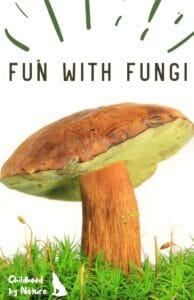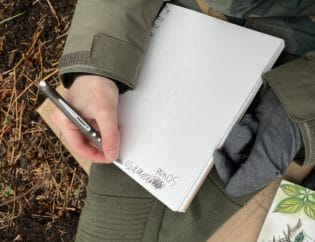
Mushrooms are of course one of the most fascinating creations that are literally under our noses. They are diverse in size, color, and shape. They can be found all over the world. And they can do everything from removing toxins from the environment to making us sick (or worse).
To help your child discover the phenomenal world of fungi, head out on a mushroom hunt together. You don’t even have to forage or harvest the fungi. You can simply discover this hidden world together, make close observations and capture the magnificent mushroom with sketches and photography. After all, nature needs fungi too.
As you go out more frequently, your child will feel a sense of achievement as they learn to identify mushrooms. This is a lifelong skill—a gift— that you can give them, just as bird, insect, tree, plant, cloud identification is. Learning about fungi provides a piece of the puzzle to the outside world. It makes nature more “known” to them and more inviting.
A very important message: Always be careful when mushroom hunting! Many mushrooms are poisonous, hallucinogenic, or medicinal. Misidentified mushrooms can make you or your child sick or kill you. Misinformation and misidentification by amateurs is prevalent on the internet. Do not rely on photos you find online. Do not eat mushrooms unless you are 100% certain that they are edible (read: not poisonous). If you have any doubts, ask an expert. You might be able to find one through your local mycological society.
When to go
Mushrooms grow throughout the year but the fall is one of the best times to find them. After a warm and wet summer, many fungi are now fruiting (aka, mushrooms!). One exception is the morel, which only grows in spring.
We’ve labeled this a rainy day activity because the best time to forage for mushrooms is after heavy rain.
Where to look
Mushrooms grow almost anywhere including the forest floor, under leaf litter, on banks of a slope, on fallen logs, inside the hollows of standing trees, and along the trunks of trees, both near the ground and high on the trunks as they stretch toward the canopy.
Beware of big mushrooms growing at the base of a tree. "It's highly likely that these mushrooms are growing from a center rot or a bud rot," mushroom expert Tradd Cotter told Treehugger. "These rots weaken the tree, and then it falls."
Are they safe to touch?
As deadly as some toxins may be, touching the mushroom is harmless. The harmful toxins in mushrooms must be consumed in order to harm you. Touch is important in identifying a mushroom as they can be fuzzy, slimy, dry, smooth, spiny, hairy, scaly, waxy and more.
What to bring
Bring along a notebook or our field notes download, pencil, colored pencils. A hand lens to get a close look at gills, pores and stems can help with identification. You should also have a few field guides or mushroom identification apps available. See our recommendations below.

How to ID a mushroom
Use your senses, except for taste! Mushrooms have amazing smells, which can help with identification. Use your eyes to get a close look, aided by a hand lens for closer detail. Feel the surface of the mushroom too!
Some features to note include color, size, where the mushroom is growing, the shape of the cap, the presence of warts on the cap, a ring along the stem, the presence of gills or pores.
 Dig Deeper
Dig Deeper
We designed our learning pack to help kids dig deeper into the fascinating world of fungi. Print out and take along these fun and educational "Fun with Fungi" activity sheets which include mushroom anatomy, vocabulary, and field observation.


















What a fun and unusual activity. Keeping kids active while out in nature doesn’t have to be super expensive to be fun. I have never gone on a mushroom hunt before but you have certainly made it seem as though it would be an amazing activity! I appreciate your approach of when, what, where, and how. I am going to add this to my plans for the next hike I take!!